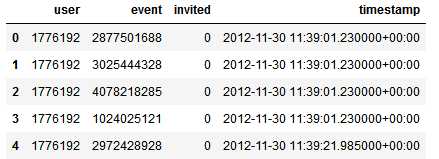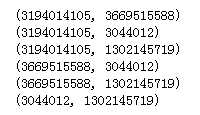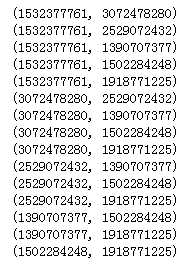标签:compress pen psi open 链接 0.00 第一步 erp objective
一、简介
此项目来自kaggle:https://www.kaggle.com/c/event-recommendation-engine-challenge/
数据集的下载需要账号,并且需要手机验证(之前如果kaggle账号已经验证过,就不需要验证了),验证的时候手机号前面需要加上860:

这里我已经将数据下载,并上传到百度云盘,链接:https://pan.baidu.com/s/1KDZN313XkbhkRDZX4dLYNA 提取码:ino3
背景介绍
根据user actions, event metadata, and demographic information(社交信息)预测用户对哪个event感兴趣
桌面新建文件夹:推荐比赛->进入推荐比赛文件夹->shift + 右键->在此处新建命令窗口->jupyter notebook->新建recommend脚本,将上面下载的数据解压到推荐比赛文件夹
1)第一步:统计user和event相关信息
我们先看看train.csv:
import pandas as pd df_train = pd.read_csv(‘train.csv‘) df_train.head()
结果如下:前两列是用户ID和对应的event ID

而test.csv中用户缺少了标签:

让我们来看看第一步的完整代码:
from collections import defaultdict
import scipy.sparse as ss
import scipy.io as sio
import itertools
#import cPickle
#From python3, cPickle has beed replaced by _pickle
import _pickle as cPickle
class ProgramEntities:
"""
我们只关心train和test中出现的user和event,因此重点处理这部分关联数据,
经过统计:train和test中总共3391个users和13418个events
"""
def __init__(self):
#统计训练集中有多少独立的用户的events
uniqueUsers = set()#uniqueUsers保存总共多少个用户:3391个
uniqueEvents = set()#uniqueEvents保存总共多少个events:13418个
eventsForUser = defaultdict(set)#字典eventsForUser保存了每个user:所对应的event
usersForEvent = defaultdict(set)#字典usersForEvent保存了每个event:哪些user点击
for filename in [‘train.csv‘, ‘test.csv‘]:
f = open(filename)
f.readline()#跳过第一行
for line in f:
cols = line.strip().split(‘,‘)
uniqueUsers.add( cols[0] )
uniqueEvents.add( cols[1] )
eventsForUser[cols[0]].add( cols[1] )
usersForEvent[cols[1]].add( cols[0] )
f.close()
self.userEventScores = ss.dok_matrix( ( len(uniqueUsers), len(uniqueEvents) ) )
self.userIndex = dict()
self.eventIndex = dict()
for i, u in enumerate(uniqueUsers):
self.userIndex[u] = i
for i, e in enumerate(uniqueEvents):
self.eventIndex[e] = i
ftrain = open(‘train.csv‘)
ftrain.readline()
for line in ftrain:
cols = line.strip().split(‘,‘)
i = self.userIndex[ cols[0] ]
j = self.eventIndex[ cols[1] ]
self.userEventScores[i, j] = int( cols[4] ) - int( cols[5] )
ftrain.close()
sio.mmwrite(‘PE_userEventScores‘, self.userEventScores)
#为了防止不必要的计算,我们找出来所有关联的用户或者关联的event
#所谓关联用户指的是至少在同一个event上有行为的用户user pair
#关联的event指的是至少同一个user有行为的event pair
self.uniqueUserPairs = set()
self.uniqueEventPairs = set()
for event in uniqueEvents:
users = usersForEvent[event]
if len(users) > 2:
self.uniqueUserPairs.update( itertools.combinations(users, 2) )
for user in uniqueUsers:
events = eventsForUser[user]
if len(events) > 2:
self.uniqueEventPairs.update( itertools.combinations(events, 2) )
#rint(self.userIndex)
cPickle.dump( self.userIndex, open(‘PE_userIndex.pkl‘, ‘wb‘))
cPickle.dump( self.eventIndex, open(‘PE_eventIndex.pkl‘, ‘wb‘) )
print(‘第1步:统计user和event相关信息...‘)
pe = ProgramEntities()
print(‘第1步完成...\n‘)
其中PE_userEventScores.mtx是所有users和events的矩阵,但是里面的值只有train.csv的值,值是1或者-1
scipy.sparse.dok_matrix()函数是产生一个稀疏矩阵,这样PE_userEventScores.mtx只保存了非0值
针对该步使用的变量作简单介绍:
uniqueUsers:集合,保存train.csv和test.csv中的所有user ID
uniqueEvents:集合,保存train.csv和test.csv中的所有event ID
eventsForUser:字典,key为每个用户,value为该用户对应的event集合
usersForEvent:字典,key为每个event,value为该event对应的user集合
userIndex:字典,每个用户有个Index
eventIndex:字典,每个event有个Index
userEventScores:稀疏矩阵3391 * 13418,use vs event,矩阵元素为train.csv中每个user对某个event的兴趣分(1, 0 or -1)即interested - not_interested
uniqueUserPairs:集合,如果对于同一个event来说,关联上3个及3个以上users,则该event关联上的users进行两两配对,保存在uniqueUserPairs中,注意保存的是userId,而不是user对应的索引:
import pandas as pd
df_train = pd.read_csv(‘train.csv‘)
df_train[df_train[‘event‘]==1502284248]
import itertools
for each in itertools.combinations(set([3044012,1302145719,3194014105,3669515588]), 2):
print(each)
代码结果示例:


uniqueEventPairs:集合,对于同一个用户,如果其关联的events大于等于3,则这些关联的events保存在uniqueEventPairs中,注意保存的是event id,而不是event对应的索引:
import pandas as pd
df_train = pd.read_csv(‘train.csv‘)
df_train[df_train[‘user‘]==3044012]
import itertools
for each in itertools.combinations(set([1918771225,1502284248,2529072432, 3072478280, 1390707377, 1532377761 ]), 2):
print(each)
代码结果示例:


cPickle模块(python3为pickle或者_pickle模块):请参考pickle详解
至此,第一步完成,哪里有不明白的请留言
我们继续看Event Recommendation Engine Challenge分步解析第二步
4)第五步:计算event热度信息
我们先来看看event_attendees.csv.gz文件
import pandas as pd df_events_attendees = pd.read_csv(‘event_attendees.csv.gz‘, compression=‘gzip‘) df_events_attendees.head()
该文件保存了某event出席情况信息:

代码如下,至此完成数据转换和存储:
from collections import defaultdict
import locale, pycountry
import scipy.sparse as ss
import scipy.io as sio
import itertools
#import cPickle
#From python3, cPickle has beed replaced by _pickle
import _pickle as cPickle
import scipy.spatial.distance as ssd
import datetime
from sklearn.preprocessing import normalize
import gzip
import numpy as np
import hashlib
#处理user和event关联数据
class ProgramEntities:
"""
我们只关心train和test中出现的user和event,因此重点处理这部分关联数据,
经过统计:train和test中总共3391个users和13418个events
"""
def __init__(self):
#统计训练集中有多少独立的用户的events
uniqueUsers = set()#uniqueUsers保存总共多少个用户:3391个
uniqueEvents = set()#uniqueEvents保存总共多少个events:13418个
eventsForUser = defaultdict(set)#字典eventsForUser保存了每个user:所对应的event
usersForEvent = defaultdict(set)#字典usersForEvent保存了每个event:哪些user点击
for filename in [‘train.csv‘, ‘test.csv‘]:
f = open(filename)
f.readline()#跳过第一行
for line in f:
cols = line.strip().split(‘,‘)
uniqueUsers.add( cols[0] )
uniqueEvents.add( cols[1] )
eventsForUser[cols[0]].add( cols[1] )
usersForEvent[cols[1]].add( cols[0] )
f.close()
self.userEventScores = ss.dok_matrix( ( len(uniqueUsers), len(uniqueEvents) ) )
self.userIndex = dict()
self.eventIndex = dict()
for i, u in enumerate(uniqueUsers):
self.userIndex[u] = i
for i, e in enumerate(uniqueEvents):
self.eventIndex[e] = i
ftrain = open(‘train.csv‘)
ftrain.readline()
for line in ftrain:
cols = line.strip().split(‘,‘)
i = self.userIndex[ cols[0] ]
j = self.eventIndex[ cols[1] ]
self.userEventScores[i, j] = int( cols[4] ) - int( cols[5] )
ftrain.close()
sio.mmwrite(‘PE_userEventScores‘, self.userEventScores)
#为了防止不必要的计算,我们找出来所有关联的用户或者关联的event
#所谓关联用户指的是至少在同一个event上有行为的用户user pair
#关联的event指的是至少同一个user有行为的event pair
self.uniqueUserPairs = set()
self.uniqueEventPairs = set()
for event in uniqueEvents:
users = usersForEvent[event]
if len(users) > 2:
self.uniqueUserPairs.update( itertools.combinations(users, 2) )
for user in uniqueUsers:
events = eventsForUser[user]
if len(events) > 2:
self.uniqueEventPairs.update( itertools.combinations(events, 2) )
#rint(self.userIndex)
cPickle.dump( self.userIndex, open(‘PE_userIndex.pkl‘, ‘wb‘))
cPickle.dump( self.eventIndex, open(‘PE_eventIndex.pkl‘, ‘wb‘) )
#数据清洗类
class DataCleaner:
def __init__(self):
#一些字符串转数值的方法
#载入locale
self.localeIdMap = defaultdict(int)
for i, l in enumerate(locale.locale_alias.keys()):
self.localeIdMap[l] = i + 1
#载入country
self.countryIdMap = defaultdict(int)
ctryIdx = defaultdict(int)
for i, c in enumerate(pycountry.countries):
self.countryIdMap[c.name.lower()] = i + 1
if c.name.lower() == ‘usa‘:
ctryIdx[‘US‘] = i
if c.name.lower() == ‘canada‘:
ctryIdx[‘CA‘] = i
for cc in ctryIdx.keys():
for s in pycountry.subdivisions.get(country_code=cc):
self.countryIdMap[s.name.lower()] = ctryIdx[cc] + 1
self.genderIdMap = defaultdict(int, {‘male‘:1, ‘female‘:2})
#处理LocaleId
def getLocaleId(self, locstr):
#这样因为localeIdMap是defaultdict(int),如果key中没有locstr.lower(),就会返回默认int 0
return self.localeIdMap[ locstr.lower() ]
#处理birthyear
def getBirthYearInt(self, birthYear):
try:
return 0 if birthYear == ‘None‘ else int(birthYear)
except:
return 0
#性别处理
def getGenderId(self, genderStr):
return self.genderIdMap[genderStr]
#joinedAt
def getJoinedYearMonth(self, dateString):
dttm = datetime.datetime.strptime(dateString, "%Y-%m-%dT%H:%M:%S.%fZ")
return "".join( [str(dttm.year), str(dttm.month) ] )
#处理location
def getCountryId(self, location):
if (isinstance( location, str)) and len(location.strip()) > 0 and location.rfind(‘ ‘) > -1:
return self.countryIdMap[ location[location.rindex(‘ ‘) + 2: ].lower() ]
else:
return 0
#处理timezone
def getTimezoneInt(self, timezone):
try:
return int(timezone)
except:
return 0
def getFeatureHash(self, value):
if len(value.strip()) == 0:
return -1
else:
#return int( hashlib.sha224(value).hexdigest()[0:4], 16) python3会报如下错误
#TypeError: Unicode-objects must be encoded before hashing
return int( hashlib.sha224(value.encode(‘utf-8‘)).hexdigest()[0:4], 16)#python必须先进行encode
def getFloatValue(self, value):
if len(value.strip()) == 0:
return 0.0
else:
return float(value)
#用户与用户相似度矩阵
class Users:
"""
构建user/user相似度矩阵
"""
def __init__(self, programEntities, sim=ssd.correlation):#spatial.distance.correlation(u, v) #计算向量u和v之间的相关系数
cleaner = DataCleaner()
nusers = len(programEntities.userIndex.keys())#3391
#print(nusers)
fin = open(‘users.csv‘)
colnames = fin.readline().strip().split(‘,‘) #7列特征
self.userMatrix = ss.dok_matrix( (nusers, len(colnames)-1 ) )#构建稀疏矩阵
for line in fin:
cols = line.strip().split(‘,‘)
#只考虑train.csv中出现的用户,这一行是作者注释上的,但是我不是很理解
#userIndex包含了train和test的所有用户,为何说只考虑train.csv中出现的用户
if cols[0] in programEntities.userIndex:
i = programEntities.userIndex[ cols[0] ]#获取user:对应的index
self.userMatrix[i, 0] = cleaner.getLocaleId( cols[1] )#locale
self.userMatrix[i, 1] = cleaner.getBirthYearInt( cols[2] )#birthyear,空值0填充
self.userMatrix[i, 2] = cleaner.getGenderId( cols[3] )#处理性别
self.userMatrix[i, 3] = cleaner.getJoinedYearMonth( cols[4] )#处理joinedAt列
self.userMatrix[i, 4] = cleaner.getCountryId( cols[5] )#处理location
self.userMatrix[i, 5] = cleaner.getTimezoneInt( cols[6] )#处理timezone
fin.close()
#归一化矩阵
self.userMatrix = normalize(self.userMatrix, norm=‘l1‘, axis=0, copy=False)
sio.mmwrite(‘US_userMatrix‘, self.userMatrix)
#计算用户相似度矩阵,之后会用到
self.userSimMatrix = ss.dok_matrix( (nusers, nusers) )#(3391,3391)
for i in range(0, nusers):
self.userSimMatrix[i, i] = 1.0
for u1, u2 in programEntities.uniqueUserPairs:
i = programEntities.userIndex[u1]
j = programEntities.userIndex[u2]
if (i, j) not in self.userSimMatrix:
#print(self.userMatrix.getrow(i).todense()) 如[[0.00028123,0.00029847,0.00043592,0.00035208,0,0.00032346]]
#print(self.userMatrix.getrow(j).todense()) 如[[0.00028123,0.00029742,0.00043592,0.00035208,0,-0.00032346]]
usim = sim(self.userMatrix.getrow(i).todense(),self.userMatrix.getrow(j).todense())
self.userSimMatrix[i, j] = usim
self.userSimMatrix[j, i] = usim
sio.mmwrite(‘US_userSimMatrix‘, self.userSimMatrix)
#用户社交关系挖掘
class UserFriends:
"""
找出某用户的那些朋友,想法非常简单
1)如果你有更多的朋友,可能你性格外向,更容易参加各种活动
2)如果你朋友会参加某个活动,可能你也会跟随去参加一下
"""
def __init__(self, programEntities):
nusers = len(programEntities.userIndex.keys())#3391
self.numFriends = np.zeros( (nusers) )#array([0., 0., 0., ..., 0., 0., 0.]),保存每一个用户的朋友数
self.userFriends = ss.dok_matrix( (nusers, nusers) )
fin = gzip.open(‘user_friends.csv.gz‘)
print( ‘Header In User_friends.csv.gz:‘,fin.readline() )
ln = 0
#逐行打开user_friends.csv.gz文件
#判断第一列的user是否在userIndex中,只有user在userIndex中才是我们关心的user
#获取该用户的Index,和朋友数目
#对于该用户的每一个朋友,如果朋友也在userIndex中,获取其朋友的userIndex,然后去userEventScores中获取该朋友对每个events的反应
#score即为该朋友对所有events的平均分
#userFriends矩阵记录了用户和朋友之间的score
#如851286067:1750用户出现在test.csv中,该用户在User_friends.csv.gz中一共2151个朋友
#那么其朋友占比应该是2151 / 总的朋友数sumNumFriends=3731377.0 = 2151 / 3731377 = 0.0005764627910822198
for line in fin:
if ln % 200 == 0:
print( ‘Loading line:‘, ln )
cols = line.decode().strip().split(‘,‘)
user = cols[0]
if user in programEntities.userIndex:
friends = cols[1].split(‘ ‘)#获得该用户的朋友列表
i = programEntities.userIndex[user]
self.numFriends[i] = len(friends)
for friend in friends:
if friend in programEntities.userIndex:
j = programEntities.userIndex[friend]
#the objective of this score is to infer the degree to
#and direction in which this friend will influence the
#user‘s decision, so we sum the user/event score for
#this user across all training events
eventsForUser = programEntities.userEventScores.getrow(j).todense()#获取朋友对每个events的反应:0, 1, or -1
#print(eventsForUser.sum(), np.shape(eventsForUser)[1] )
#socre即是用户朋友在13418个events上的平均分
score = eventsForUser.sum() / np.shape(eventsForUser)[1]#eventsForUser = 13418,
#print(score)
self.userFriends[i, j] += score
self.userFriends[j, i] += score
ln += 1
fin.close()
#归一化数组
sumNumFriends = self.numFriends.sum(axis=0)#每个用户的朋友数相加
#print(sumNumFriends)
self.numFriends = self.numFriends / sumNumFriends#每个user的朋友数目比例
sio.mmwrite(‘UF_numFriends‘, np.matrix(self.numFriends) )
self.userFriends = normalize(self.userFriends, norm=‘l1‘, axis=0, copy=False)
sio.mmwrite(‘UF_userFriends‘, self.userFriends)
#构造event和event相似度数据
class Events:
"""
构建event-event相似度,注意这里有2种相似度
1)由用户-event行为,类似协同过滤算出的相似度
2)由event本身的内容(event信息)计算出的event-event相似度
"""
def __init__(self, programEntities, psim=ssd.correlation, csim=ssd.cosine):
cleaner = DataCleaner()
fin = gzip.open(‘events.csv.gz‘)
fin.readline()#skip header
nevents = len(programEntities.eventIndex)
print(nevents)#13418
self.eventPropMatrix = ss.dok_matrix( (nevents, 7) )
self.eventContMatrix = ss.dok_matrix( (nevents, 100) )
ln = 0
for line in fin:
#if ln > 10:
#break
cols = line.decode().strip().split(‘,‘)
eventId = cols[0]
if eventId in programEntities.eventIndex:
i = programEntities.eventIndex[eventId]
self.eventPropMatrix[i, 0] = cleaner.getJoinedYearMonth( cols[2] )#start_time
self.eventPropMatrix[i, 1] = cleaner.getFeatureHash( cols[3] )#city
self.eventPropMatrix[i, 2] = cleaner.getFeatureHash( cols[4] )#state
self.eventPropMatrix[i, 3] = cleaner.getFeatureHash( cols[5] )#zip
self.eventPropMatrix[i, 4] = cleaner.getFeatureHash( cols[6] )#country
self.eventPropMatrix[i, 5] = cleaner.getFloatValue( cols[7] )#lat
self.eventPropMatrix[i, 6] = cleaner.getFloatValue( cols[8] )#lon
for j in range(9, 109):
self.eventContMatrix[i, j-9] = cols[j]
ln += 1
fin.close()
self.eventPropMatrix = normalize(self.eventPropMatrix, norm=‘l1‘, axis=0, copy=False)
sio.mmwrite(‘EV_eventPropMatrix‘, self.eventPropMatrix)
self.eventContMatrix = normalize(self.eventContMatrix, norm=‘l1‘, axis=0, copy=False)
sio.mmwrite(‘EV_eventContMatrix‘, self.eventContMatrix)
#calculate similarity between event pairs based on the two matrices
self.eventPropSim = ss.dok_matrix( (nevents, nevents) )
self.eventContSim = ss.dok_matrix( (nevents, nevents) )
for e1, e2 in programEntities.uniqueEventPairs:
i = programEntities.eventIndex[e1]
j = programEntities.eventIndex[e2]
if not ((i, j) in self.eventPropSim):
epsim = psim( self.eventPropMatrix.getrow(i).todense(), self.eventPropMatrix.getrow(j).todense())
self.eventPropSim[i, j] = epsim
self.eventPropSim[j, i] = epsim
if not ((i, j) in self.eventContSim):
ecsim = csim( self.eventContMatrix.getrow(i).todense(), self.eventContMatrix.getrow(j).todense())
self.eventContSim[i, j] = ecsim
self.eventContSim[j, i] = ecsim
sio.mmwrite(‘EV_eventPropSim‘, self.eventPropSim)
sio.mmwrite(‘EV_eventContSim‘, self.eventContSim)
class EventAttendees:
"""
统计某个活动,参加和不参加的人数,从而为活动活跃度做准备
"""
def __init__(self, programEntities):
nevents = len(programEntities.eventIndex)#13418
self.eventPopularity = ss.dok_matrix( (nevents, 1) )
f = gzip.open(‘event_attendees.csv.gz‘)
f.readline()#skip header
for line in f:
cols = line.decode().strip().split(‘,‘)
eventId = cols[0]
if eventId in programEntities.eventIndex:
i = programEntities.eventIndex[eventId]
self.eventPopularity[i, 0] = len(cols[1].split(‘ ‘)) - len(cols[4].split(‘ ‘))#yes人数-no人数,即出席人数减未出席人数
f.close()
self.eventPopularity = normalize( self.eventPopularity, norm=‘l1‘, axis=0, copy=False)
sio.mmwrite(‘EA_eventPopularity‘, self.eventPopularity)
def data_prepare():
"""
计算生成所有的数据,用矩阵或者其他形式存储方便后续提取特征和建模
"""
print(‘第1步:统计user和event相关信息...‘)
pe = ProgramEntities()
print(‘第1步完成...\n‘)
print(‘第2步:计算用户相似度信息,并用矩阵形式存储...‘)
#Users(pe)
print(‘第2步完成...\n‘)
print(‘第3步:计算用户社交关系信息,并存储...‘)
#UserFriends(pe)
print(‘第3步完成...\n‘)
print(‘第4步:计算event相似度信息,并用矩阵形式存储...‘)
#Events(pe)
print(‘第4步完成...\n‘)
print(‘第5步:计算event热度信息...‘)
EventAttendees(pe)
print(‘第5步完成...\n‘)
#运行进行数据准备
data_prepare()
Event Recommendation Engine Challenge分步解析第一步
标签:compress pen psi open 链接 0.00 第一步 erp objective
原文地址:https://www.cnblogs.com/always-fight/p/10248084.html